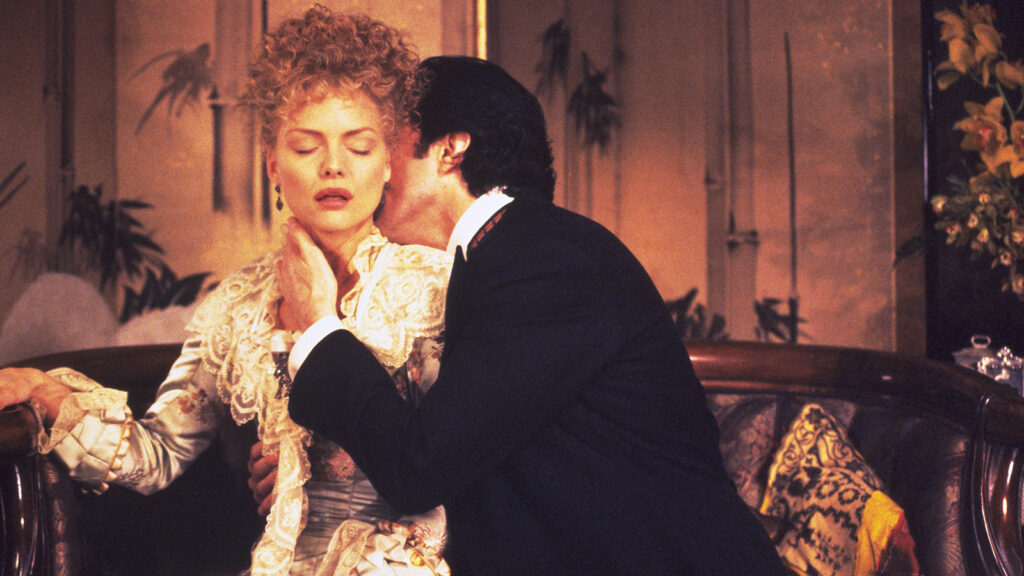It was undoubtedly gratifying to be the husband of one of the handsomest and most popular young married women in New York, especially when she was also one of the sweetest-tempered and most reasonable wives; and Archer had never been insensible to such advantages. As for the momentary madness, which had fallen upon him on the eve of his marriage, he had trained himself to regard it as the last of his discarded experiments. The idea that he could ever, in his senses, have dreamed of marrying Countess Olenska had become almost unthinkable, and she remained in his memory simply as the most plaintive and poignant of a line of ghosts.

From the very beginning of Martin Scorsese’s The Age Of Innocence (1993) the focus is Newland Archer (Daniel Day-Lewis). He is first to appear and it is from his box at the opera which Scorsese allows his audience to see the sequence unfold. The audience’s empathy is immediately invested in Newland Archer, assumes that this is his story. In Wharton’s text the first two paragraphs deal exclusively with the societal goings on at the opera but Scorsese seems to bypass the significant action in the introductory pages, simply allowing those menial events to play out almost unnoticed in the background of Newland Archer’s scene. Wharton reinforces the notion that hers is a novel about a society with no one central hero, dutifully following through with a sort of “background story” for each character, no matter how trifle.
Archer, in the novel, is a character Wharton seems to use as a ship on which she sails her reader through the complex world whose social mechanisms she so satirically scrutinizes. Throughout the film, and especially at the van der Luyden’s party for Countess Olenska (Michelle Pfeiffer), Scorsese permits Archer to lead the frame and in turn the audience. This device implies that Archer moves the narrative, that his story is the focus, his is the important character, and that all of Wharton’s other characters are merely present to support and help to explore the character of Newland Archer and his immediate world. In the same sequence, Scorsese and his cinematographer Michael Ballhaus (this was their second film together, the other being The Last Temptation Of Christ), provide numerous eye line matches for Newland Archer. The audience is only permitted then, to look away from Newland Archer when he looks at a person or object out of frame that has some significance to his character. Newland Archer, throughout all of the film is completely empowered with carrying the audience narratively and empathetically; hence the film becomes Newland Archer. Wharton does not immediately go to Newland Archer to paint her scenes; her backdrop is a tongue in cheek analysis of the hosts, the van der Luydens. Scorsese’s incorporation less illustrative interpretation was a pan of a table at which the characters (not dissimilar to the moving camera shots of interiors in Kubrick’s Barry Lyndon) were seated; a pan whose direction followed Newland Archer’s gaze.
What political concerns that are apparent in Scorsese’s film are Wharton’s themes of romantic and sexual suppression. Scorsese illustrates this most effectively with the visual palette in the Coach Scene. Here, Newland Archer removes the glove of his would-be mistress as they take a carriage ride from the train station to the Mignott house. In slow motion, with a warm tone, Scorsese and Balhaus collaborate to push the sexual signifiers further while the suppression is read by the audience in the character’s facial expressions. The critical difference here is that Scorsese still harbors a sincere trust in the narrative and the role of the so-called hero which Wharton quite readily rejects in her approach to The Age Of Innocence. This in turn justifies or rather explains each artist’s take on tradition and its political ramifications. One may assume that Scorsese perceives these traditions as a foil or plot device in the romantic story of Newland Archer. While on the contrary, Wharton uses the subversive effects on her characters induced by tradition to further dissect and criticize the society which her characters occupy. Does Newland Archer not desire Countess Olenska simply because he cannot posses her, is that not the root of his obsession?
